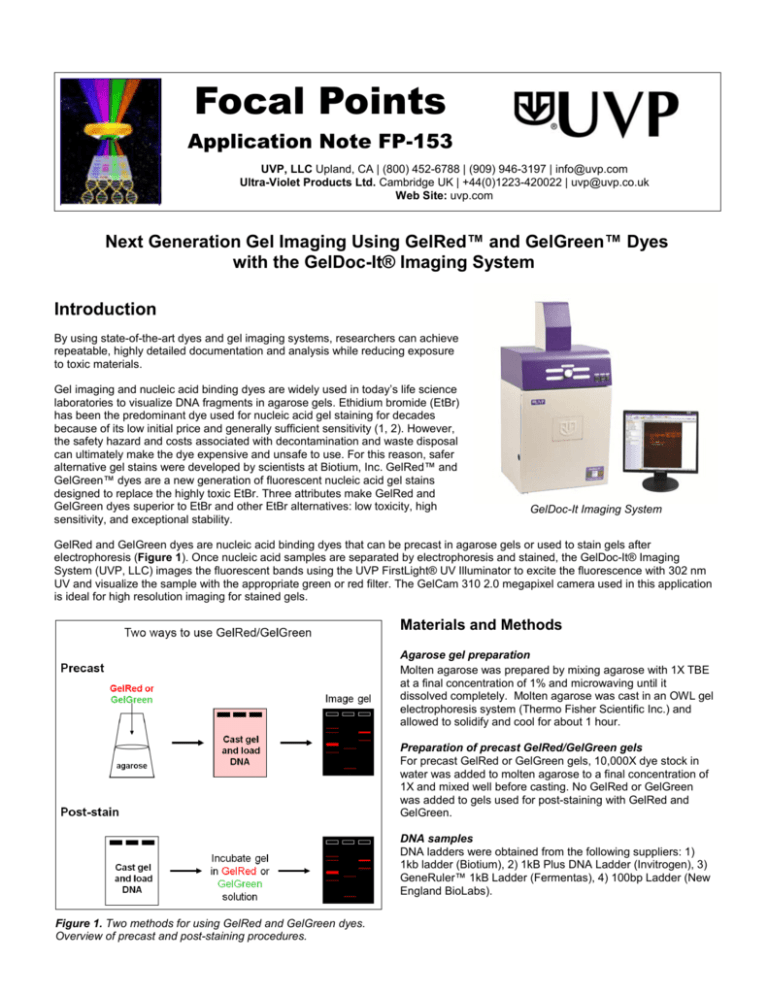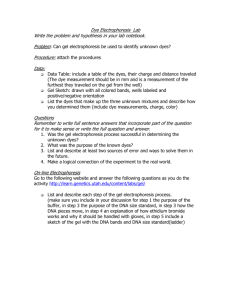
Focal Points
Application Note FP-153
UVP, LLC Upland, CA | (800) 452-6788 | (909) 946-3197 | info@uvp.com
Ultra-Violet Products Ltd. Cambridge UK | +44(0)1223-420022 | uvp@uvp.co.uk
Web Site: uvp.com
Next Generation Gel Imaging Using GelRed™ and GelGreen™ Dyes
with the GelDoc-It® Imaging System
Introduction
By using state-of-the-art dyes and gel imaging systems, researchers can achieve
repeatable, highly detailed documentation and analysis while reducing exposure
to toxic materials.
Gel imaging and nucleic acid binding dyes are widely used in today’s life science
laboratories to visualize DNA fragments in agarose gels. Ethidium bromide (EtBr)
has been the predominant dye used for nucleic acid gel staining for decades
because of its low initial price and generally sufficient sensitivity (1, 2). However,
the safety hazard and costs associated with decontamination and waste disposal
can ultimately make the dye expensive and unsafe to use. For this reason, safer
alternative gel stains were developed by scientists at Biotium, Inc. GelRed™ and
GelGreen™ dyes are a new generation of fluorescent nucleic acid gel stains
designed to replace the highly toxic EtBr. Three attributes make GelRed and
GelGreen dyes superior to EtBr and other EtBr alternatives: low toxicity, high
sensitivity, and exceptional stability.
GelDoc-It Imaging System
GelRed and GelGreen dyes are nucleic acid binding dyes that can be precast in agarose gels or used to stain gels after
electrophoresis (Figure 1). Once nucleic acid samples are separated by electrophoresis and stained, the GelDoc-It® Imaging
System (UVP, LLC) images the fluorescent bands using the UVP FirstLight® UV Illuminator to excite the fluorescence with 302 nm
UV and visualize the sample with the appropriate green or red filter. The GelCam 310 2.0 megapixel camera used in this application
is ideal for high resolution imaging for stained gels.
Materials and Methods
Agarose gel preparation
Molten agarose was prepared by mixing agarose with 1X TBE
at a final concentration of 1% and microwaving until it
dissolved completely. Molten agarose was cast in an OWL gel
electrophoresis system (Thermo Fisher Scientific Inc.) and
allowed to solidify and cool for about 1 hour.
Preparation of precast GelRed/GelGreen gels
For precast GelRed or GelGreen gels, 10,000X dye stock in
water was added to molten agarose to a final concentration of
1X and mixed well before casting. No GelRed or GelGreen
was added to gels used for post-staining with GelRed and
GelGreen.
DNA samples
DNA ladders were obtained from the following suppliers: 1)
1kb ladder (Biotium), 2) 1kB Plus DNA Ladder (Invitrogen), 3)
GeneRuler™ 1kB Ladder (Fermentas), 4) 100bp Ladder (New
England BioLabs).
Figure 1. Two methods for using GelRed and GelGreen dyes.
Overview of precast and post-staining procedures.
Focal Points Application Note
2
DNA ladders were mixed with 6X DNA loading buffer (7.5%
Ficoll, 15% glycerol, 0.1% Patent Blue VF, 0.05%
Bromophenol Blue; 2 uL 6X loading buffer + 10 uL DNA
ladder) before loading onto gels.
Gel electrophoresis
Electrophoresis was performed in 1X TBE at 100 V until
tracking dyes had migrated half the length of the gel.
Pre-cast GelRed/GelGreen gels were imaged immediately
following electrophoresis.
Post-electrophoresis gel staining
DNA samples were loaded on agarose gels containing no
fluorescent nucleic acid dye. After electrophoresis, gels
were stained in 3X GelRed or GelGreen in water for 30
minutes before imaging.
Gel imaging
Gels were imaged using a GelDoc-It Imaging System
equipped with the 302 nm FirstLight UV Illuminator (UVP,
LLC) for uniform illumination, GelCam 310, and EtBr and
green emission filters. Images were typically acquired at
0.25 to 2 second exposure times with the VisionWorks®LS
software (UVP, LLC).
Figure 2. Excitation and emission spectra of GelRed and
GelGreen dyes bound to dsDNA.
Cell membrane permeability studies
Cell staining procedures investigating the membrane
permeability of dyes were performed in HeLa cells cultured in
DMEM supplemented with 10% BCS and antibiotics. Cells were
incubated in 1X concentrations of SYBR® Safe (Invitrogen),
GelRed or GelGreen diluted from 10,000X stocks. Microscopic
images of cells were captured using an Olympus America, Inc.
mercury arc lamp microscope and Image-Pro® Express software
(Media Cybernetics, Inc.).
Results
Designed primarily for use with a 302 nm UV transilluminator,
GelRed dye is spectrally similar to EtBr. GelGreen dye is also
compatible with UV transilluminators but was developed to meet
the needs of researchers who use a 488 nm laser-based gel
scanner or systems that use visible blue light for excitation.
Excitation and emission of GelRed and GelGreen dyes make it
optically compatible with UV transilluminators and other
documentation systems (Figure 2).
DNA fragments in GelRed and GelGreen post-stained gels were
imaged on the GelDoc-It imaging system and documented using
the VisionWorks LS image acquisition and analysis software
(Figure 3). Images of GelRed gels were obtained using the EtBr
emission filter and pseudocolored red while images of GelGreen
gels were obtained using the green emission filter and
pseudocolored green.
Figure 3. GelRed and GelGreen post-stained gels. DNA
ladders were separated on a 1% agarose TBE gel and
stained in 3X GelRed or 3X GelGreen in water. Samples in
the lanes are as follows: 1) 1kb ladder (Biotium), 2) 1kB
Plus DNA Ladder (Invitrogen), 3) GeneRuler 1kB Ladder
Figure 3
(Fermentas), 4) 100bp Ladder (New England BioLabs). The
total DNA mass loaded in each well was 200 ng. Images
were taken on a GelDoc-It system equipped with the FirstLight UV transilluminator, GelCam 310 Camera, and EtBr emission
filter (GelRed) or green emission filter (GelGreen) using the VisionWorks LS software and pseudocolored red or green.
Focal Points Application Note
3
To compare the sensitivity of GelRed and EtBr, precast agarose
gels were loaded with two-fold dilutions of 1 kB Plus DNA Ladder
(Invitrogen). EtBr migrates through gels toward the anode during
electrophoresis, resulting in poor staining of low molecular weight
bands and high background in the region of high molecular weight
bands (Figure 4).
GelRed in precast gels does not migrate as readily as EtBr during
electrophoresis, resulting in more uniform staining of high and low
molecular weight bands. A band containing approximately 2 ng of
DNA can be clearly detected using GelRed (Figure 4),
demonstrating that DNA fragments in the nanogram range are
readily detectable using GelRed dye and the GelDoc-It system. The
fluorescence intensity of the dye combined with the excitation and
imaging capacity of the GelDoc-It system allow for highly sensitive
detection of nucleic acids.
Figure 4. Comparison of EtBr and GelRed in precast gels.
Two-fold serial dilutions of 1 kb Plus DNA Ladder
(Invitrogen) were loaded in the amounts of 200 ng, 100 ng,
50 ng and 25 ng per well from left to right. Images were
taken on a GelDoc-It system equipped with a FirstLight
302 nm transilluminator, EtBr and green emission filter.
Gel images were captured using the GelCam 310 and
VisionWorks LS software and pseudocolored red. The
band in the far right lane marked by the asterisk (*)
contains approximately 2 ng DNA.
Figure 4
To demonstrate the safety of GelRed and GelGreen dyes, the membrane permeability of the dyes was assessed. HeLa cells were
stained with SYBR® Safe DNA gel stain, GelRed and GelGreen dyes at 1X concentration from 10,000X stocks. SYBR Safe readily
penetrated the cells and stained DNA while no nuclear staining was evident with GelRed and GelGreen (Figure 5).
Figure 5. Comparison of membrane permeability of SYBR Safe, GelRed, and GelGreen. HeLa cells were
incubated for 30 minutes at 37ºC with 1X SYBR Safe, GelRed, and GelGreen dyes. SYBR Safe entered cells
rapidly as evident from the bright green nuclear staining. However, GelRed and GelGreen dyes were unable to
cross cell membranes as shown by the absence of fluorescence staining.
Focal Points Application Note
4
Discussion
Traditionally, imaging of EtBr gels using tube based UV transilluminators and film has been the means to detect and document
nucleic acid bands in gels. However, newer technologies, such as safer, brighter, and simple to use nucleic acid binding dyes and
imaging systems that incorporate GelCam 310 camera, uniform illuminators, and analytical software outperform imaging with EtBr
and film.
GelRed and GelGreen dyes have been shown to be less toxic and more sensitive than EtBr and SYBR Safe. The genotoxicity of
DNA-binding dyes can be substantially reduced by preventing dye binding to genomic DNA in living cells. Thus, Biotium scientists
engineered the chemical structures of GelRed and GelGreen such that the dyes are incapable of crossing the plasma membrane of
viable cells. In contrast, SYBR dyes, including SYBR Safe, penetrate living cells rapidly and stain mitochondria and nuclear DNA
(Figure 5), making it more likely for the dyes to be toxic and mutagenic. Indeed, SYBR Green I has been reported to strongly
potentiate DNA mutation by UV light and other genotoxic agents (3). Standard Ames tests conducted by independent laboratories
have confirmed that GelRed and GelGreen dyes are nonmutagenic and noncytotoxic at concentrations well above their working
concentrations. Furthermore, environmental safety tests showed that GelRed and GelGreen dyes are nonhazardous and nontoxic
to aquatic life. GelRed and GelGreen successfully passed the Aquatic Toxicity Test (CCR Title 22) based on the EPA/600/4-85/013
protocol (please visit www.biotium.com to download a detailed safety report on GelRed and GelGreen).
GelRed and GelGreen offer several additional advantages over EtBr and other nucleic acid dyes. When used in precast gels,
GelRed does not migrate through the gel as easily as EtBr; therefore, there is less disparity between high molecular weight and low
molecular weight staining intensities (Figure 4), and it is not necessary to add the dyes to the running buffer for maximal sensitivity.
Also, unlike EtBr, destaining after post-staining with GelRed is not necessary due to the low intrinsic fluorescence of GelRed dye
when not bound to nucleic acids. GelGreen dye offers superior sensitivity and chemical stability over other green nucleic acid
binding dyes such as SYBR Safe or SYBR Gold and allows for visible light excitation for those who wish to minimize UV exposure
to themselves and their DNA samples (Figure 2). GelRed and GelGreen are highly stable at room temperature for long-term
storage. Both dyes are also very photostable, permitting their use under normal room light without exercising special precaution. In
addition to 10,000X GelRed and GelGreen in water, 3X GelRed in water (4L unit size) is available for post-staining applications
(Figure 1).
The FirstLight Illuminator offers a unique patented design emitting 302 nm ultraviolet excitation and combines a specially designed,
high density grid array ultraviolet lighting configuration with a phosphor coating to generate exceptionally uniform ultraviolet
illumination. It produces less than 5% coefficient of variance (CV) across the full imaging surface, which is essential for capturing
high quality images for documentation and quantitative analysis. The FirstLight Illuminator design assures consistent sensitivity and
dynamic range for achieving accurate and reproducible gel analysis no matter where the gel is placed on the surface.
In addition, the digital, high resolution, GelCam 310 camera offered with the GelDoc-It Imaging System is a step above traditional
film documentation.
Conclusion
Innovative technologies such as Biotium’s nucleic acid binding dyes and UVP’s advanced imaging systems allow for highly sensitive
imaging documentation and analysis. These systems, in combination with top-quality reagents and software, minimize effort and
maximize informative results in today’s life science laboratories.
References
1.
2.
3.
Gallagher, S.R. and Wiley, E.A. Current Protocols: Essential Laboratory Techniques. 2008.
Armstrong, J and Schulz, J. 2008. Agarose Gel Electrophoresis. Curr. Protoc. Essential Lab. Tech. Unit 7.2.
Ohta T, Tokishita S, and Yamagata H. 2001. Ohta T, Tokishita S, and Yamagata H. 2001. Ethidium bromide and SYBR
Green I enhance the genotoxicity of UV-irradiation and chemical mutagens in E. coli. Mutation Res. 492, 91.
© 2010 UVP, LLC All rights reserved. Under the copyright laws, this document may not be copied, in whole or in part, without the
written consent of UVP. Every effort has been made to ensure that the information in this document is accurate. UVP is not
responsible for printing or clerical errors.
UVP logo, FirstLight, VisionWorks and GelDoc-It are registered trademarks of UVP, LLC. All other trademarks are recognized as
owned by their respective companies.
FP-153 R060911






